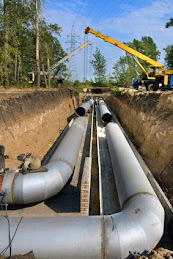A friend of mine lives on the bottom floor of a condo complex and, much to her ire, she is frequently saddled with the mess of having to clean sewage out of her bathtubs. The aging sewer system in her building means that sewage backups are becomming all too frequent for bottom (floor) dwellers while upstairs dwellers continue to flush their toilets with oblivious abandon.
Perhaps a surge of waste water is blocked so sewage may back up into the home fixtures (bathtubs, toilets, sinks), usually at the lowest plumbing fixture. Sometimes it's not the wastewater surge but someone flushing something down a toilet that blocks a drain - that's a problem that can be cleared by a New York plumber using a plumbing snake or drain router.
If the toilet is about to overflow here is what you do to prevent sewage from running over the toilet bowl and onto the floor:
1) Take off the toilet tank lid
2) Reach inside the toilet and push down the flapper valve that is letting the tank empty water into the toilet bowl - this will stop water from entering the toilet and if you're quick enough, prevent sewage from overflowing onto the floor. This will be a rubber valve in the center of the bottom of the toilet tank.
3) If the water level in the toilet bowl is dropping slowly, hold the toilet tank float up in its highest position so that water stops flowing into the tank and into the toilet bowl.
If the water level in the toilet bowl slowly drops down to a normal level, you'll be able to release the toilet tank float and let the tank and toilet bowl refill without danger of overflowing onto the floor.
4)If the water level in the toilet tank is not dropping continue to hold up the toilet tank float while you close the toilet shut-off valve near the floor or in the wall behind the toilet. (Here is my caveat - make sure that you replace the shut off valve if it is old - I once had my shut-off valve break off in my hand, letting water spray everywhere while I pannicked in the midst of a flood. This would not have happened if I had had a competant Westchester County Sewer Contractor replace the shut-off valves. If you missed this important step - don't force the handle of the shut-off valve for fear of breaking it and compounding your problems.)
Hopefully you have read this before the problem began because it is impossible to browse the internet whilst holding a shut off valve in one hand and a flapper in the other. In any case, you'll probably want to call a New York Plumber or Westchester County Sewer Line Contractor if the problems are greater than a blocked fixture. In the mean time:
* Stop using all toilets and fixtures: stop running water in sinks and showers etc. while you investigate.
* When checking upper floor fixtures ask someone to look at the lower floor toilets and drains - otherwise you may think that upstairs drains are working when in fact they're simply backing up out of the lower floor toilets.
* If all of the toilets or drains are backing up or slow, you may have a Westchester County Blocked drain or a flooded failing septic field. If so you will have to stop using toilets and sinks indoors. It's possible that after letting the drainfield rest for an hour or so you may be able to return to modest use of toilets. Meanwhile do not run any water into any drains if you can avoid it.
* If your home is connected to a private septic tank, look outside at the septic fields: do you see evidence of septic effluent at the surface? If so, no amount of plunging will correct the problem.
* If your home is connected to a municipal sewer, you may have a blocked main drain.
* If your home uses a sewage ejector pump or septic pump, check that the pump has electrical power, is turned on, and is working.
Subscribe to:
Post Comments (Atom)

No comments:
Post a Comment